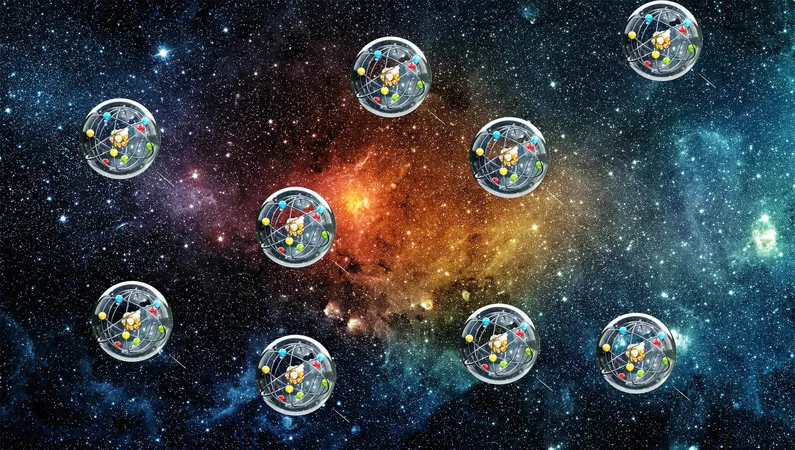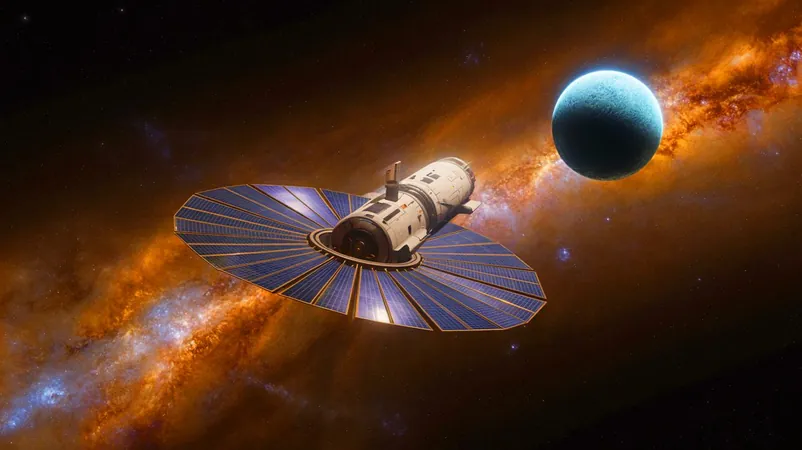
Cosmic Clues: How Organic Molecules Found in Deep Space Could Reveal the Origins of Life on Earth
2024-12-29
Author: Chun
Cosmic Clues: How Organic Molecules Found in Deep Space Could Reveal the Origins of Life on Earth
In an exciting revelation, scientists have uncovered a vast array of organic molecules scattered throughout the cosmos, hinting that the building blocks of life may have originated from deep space. These carbon-based compounds, prevalent in comets, asteroids, and interstellar dust, suggest that the story of life on Earth could be part of a larger, universal narrative.
Robotic missions over recent years have yielded invaluable samples from celestial bodies like comets and asteroids, aiming to unravel the origins of these organic compounds and their role in the formation of biological chemistry on our planet. Such findings indicate that organic materials are not just rare anomalies, but rather commonplace throughout the universe.
The Cosmic Organic Bounty
Research into cosmic materials has consistently revealed that celestial objects—including interstellar dust and rocky remnants from the dawn of our solar system—harbor a rich diversity of organic molecules. This intrigue began in 1986 with the European Giotto spacecraft’s historic encounter with comet 1P/Halley, where it detected an unexpectedly high concentration of organic molecules in the comet’s coma. However, the exact origins of these molecules—whether they were formed from polymeric substances or smaller compounds—remained elusive.
The Rosetta mission marked another major advancement in our understanding. Notably, in 2015, Rosetta became the first spacecraft to successfully orbit and land on a comet, specifically 67P. Its noble quest resulted in the direct detection of glycine, an essential compound in protein formation—marking a significant milestone in astrobiology.
By 2022, high-resolution mass spectrometry data from Rosetta identified 44 distinct organic compounds in a surprisingly short timeframe. Among these was dimethyl sulfide, a gas typically associated with biological activity on Earth, further suggesting that the universe may be rife with prebiotic chemistry.
Asteroids: Time Capsules of the Ancient Solar System
Japan's Hayabusa2 and NASA's OSIRIS-REx missions have also illuminated the story of organic molecules. These missions returned samples from asteroids Ryugu and Bennu, revealing a staggering array of carbon-based compounds—over 20,000 types, including 15 different amino acids. Philippe Schmitt-Kopplin, an organic geoscientist, emphasized, "It’s just everything possible from which life could emerge," indicating that these ancient minerals could predate the formation of planets themselves.
The Great Cosmic Question: How Did Life Begin?
Scientists grapple with profound questions regarding planetary origins. Did organic compounds originate in icy, dark clouds between stars, or did they form in the fiery environments surrounding young stars? Understanding this could unlock the secrets of how celestial bodies accumulate organics in the absence of life, a paramount challenge for astrobiologists.
Notably, various researchers propose that early Earth may owe its habitability in part to organic molecules introduced via meteorites and comets. “I would like to know where we come from as a planetary species,” said astrochemist Karin Öberg, highlighting the quest for understanding our cosmic heritage.
The Chemistry of the Cosmos
Astronomers trace certain carbon structures, known as polycyclic aromatic hydrocarbons (PAHs), back to 1.5 billion years after the Big Bang. These molecules are believed to form in the winds of dying stars, mirroring combustion processes we observe on Earth. Observations reveal that interstellar space is home to over 200 known carbon-containing compounds, pointing to a rich chemistry that exists beyond our planet.
Future Insights and Investigations
As simple ingredients accumulate in molecular clouds on cold dust grains, knowledge advances about how conditions in these realms can foster complex organic chemistry. Earth’s own origins beckon scrutiny as future missions, such as NASA's Europa Clipper and ESA's Juice, venture to explore icy moons believed to harbor subsurface oceans.
The potential discovery of organic compounds hidden beneath the icy crusts of these moons would deepen our understanding of life's emergence and evolution—leading humanity closer to answering one of its most profound questions: Are we alone in the universe?
The race to unveil the mysteries of these organic molecules continues, and with each new discovery, we inch closer to understanding our cosmic fortune—the tantalizing clue that perhaps life as we know it may not be so unique after all.


 Brasil (PT)
Brasil (PT)
 Canada (EN)
Canada (EN)
 Chile (ES)
Chile (ES)
 Česko (CS)
Česko (CS)
 대한민국 (KO)
대한민국 (KO)
 España (ES)
España (ES)
 France (FR)
France (FR)
 Hong Kong (EN)
Hong Kong (EN)
 Italia (IT)
Italia (IT)
 日本 (JA)
日本 (JA)
 Magyarország (HU)
Magyarország (HU)
 Norge (NO)
Norge (NO)
 Polska (PL)
Polska (PL)
 Schweiz (DE)
Schweiz (DE)
 Singapore (EN)
Singapore (EN)
 Sverige (SV)
Sverige (SV)
 Suomi (FI)
Suomi (FI)
 Türkiye (TR)
Türkiye (TR)
 الإمارات العربية المتحدة (AR)
الإمارات العربية المتحدة (AR)